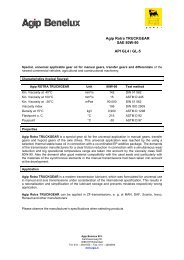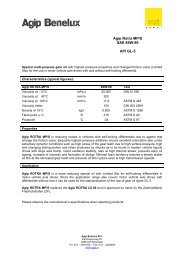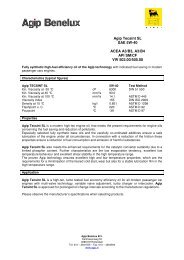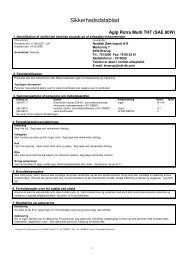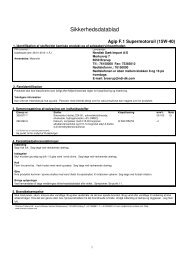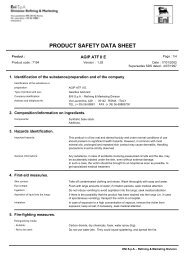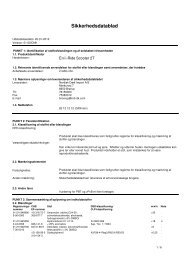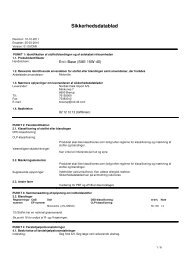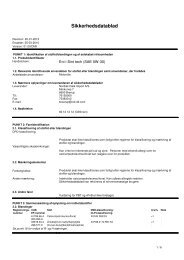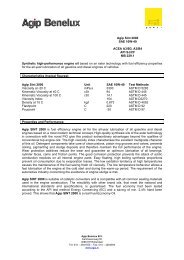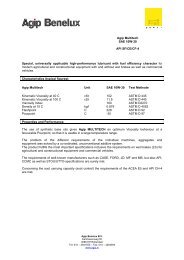Agip Formula Moto City TEC 2T Page 1
Agip Formula Moto City TEC 2T Page 1
Agip Formula Moto City TEC 2T Page 1
Create successful ePaper yourself
Turn your PDF publications into a flip-book with our unique Google optimized e-Paper software.
<strong>Agip</strong> Schmiertechnik<br />
MATERIAL SAFETY DATA SHEET according to 1907/2006/EC<br />
Date of issue: 20.04.2007 Revised on: 05.11.2008<br />
1. Identification of the substance/preparation and of the company.<br />
Identification of the substance or<br />
preparation: AGIP <strong>Formula</strong> <strong>Moto</strong> <strong>City</strong> <strong>TEC</strong> <strong>2T</strong><br />
Type of product and use: Lubricant for 2-stroke engines<br />
Company identification: <strong>Agip</strong> Schmiertechnik GmbH<br />
Address and telephone no.: Paradiesstr. 14, 97080 Würzburg<br />
TEL. (+ 49) 931 - 900 98-145 FAX (+ 49) 931-98442<br />
MSDS/2/1108/0273_KE e<br />
<strong>Agip</strong> <strong>Formula</strong> <strong>Moto</strong> <strong>City</strong> <strong>TEC</strong> <strong>2T</strong> <strong>Page</strong> 1 of 5<br />
Advising/Support: Mr. Friese (Ulrich.Friese@agip.de), Safety Engineer/Technical Department<br />
Tel. (+ 49) 931/900 98-145 (during working hours)<br />
Tel. (+ 49) 931/900 98-0 (answering machine)<br />
2. Hazards identification.<br />
Physical-chemical dangers:<br />
May cause sensitisation by skin contact.<br />
Important hazards: Product with a low risk of fire. It can create flammable mixtures or burn only if heated at<br />
temperatures which are higher than normal ambient levels.<br />
Dangers for human health:<br />
Skin contact: Prolonged and repeated skin contact, especially if hygiene practices are poor, may<br />
cause reddening, irritation and dermatitis.<br />
Eye contact: Contact with eyes may cause reddening and irritation.<br />
Ingestion: Accidental ingestion of small quantities of the product may cause nausea, discomfort<br />
and gastric disturbances. Taking into account the taste and smell of the product,<br />
however, ingestion of dangerous quantities is very unlikely.<br />
Inhalation: This product has a low vapour pressure, and in normal conditions at ambient<br />
temperature the concentration in the air is negligible. A significant concentration may<br />
build up only if the product is used at high temperature, or in case of sprays and mists.<br />
In these cases overexposure to vapours (e. g. through prolonged use in confined<br />
insufficiently ventilated spaces) may cause irritation to airways, nausea and dizziness.<br />
Aspiration of liquid into the lungs: The aspiration of small amounts of foreign substances into the lungs may cause<br />
irritation and inflammation (chemical pneumonia). Taking into account the composition<br />
of the product, however, this possibility should be regarded as unlikely.<br />
Other information: Any substance, in case of accidents involving pressurized circuits and the like, may be<br />
accidentally injected under the skin, even without external damage. In such a case, the<br />
victim should be brought to a hospital as soon as possible, to get specialized medical<br />
treatment.<br />
3. Composition/information on ingredients.<br />
Substances that are a health risk according to R.D. 363/1995, Rules and Regulations on Dangerous Substances:<br />
Designation: Alkylphenol, 0 - 0,249%<br />
CAS-no. 121158-58-5, EC-no. 310-154-3<br />
Symbols: N, Xi, Xn; R-sets: R50/53-38-41-62<br />
Lubricating oil, extracted with a solvent and dewaxed, hydrogenated, 25 - 49,99%<br />
Index-no. 649-530-00-X, CAS-no. 101316-72-7, EC-no. 309-877-7<br />
Calcium sulphonate neutral, 0 - 24,99%<br />
CAS-no. 90268-85-2, Symbol: Xi; R-sets: R52/53-43<br />
The complete text of the R-sets is given in section 16 of this Safety Data Sheet.<br />
4. First aid measures.<br />
Skin contact: Take off contaminated clothing and shoes. Wash thoroughly with soap and water. If<br />
inflammation or irritation persists, seek medical advice.<br />
Eye contact: Rinse eyes thoroughly for at least 10 minutes. Keep eyelids well apart. If irritation<br />
persists, seek medical advice.<br />
Ingestion: Do not induce vomiting to avoid aspiration into the lungs. If the person in conscious,<br />
rinse mouth with water without swallowing. Keep at rest. Call for medical assistance or<br />
bring to a hospital.
<strong>Agip</strong> Schmiertechnik<br />
MATERIAL SAFETY DATA SHEET according to 1907/2006/EC<br />
Date of issue: 20.04.2007 Revised on: 05.11.2008<br />
MSDS/2/1108/0273_KE e<br />
<strong>Agip</strong> <strong>Formula</strong> <strong>Moto</strong> <strong>City</strong> <strong>TEC</strong> <strong>2T</strong> <strong>Page</strong> 2 of 5<br />
Inhalation: In case of disturbances owing to an exposure to a high concentration of vapours or<br />
mists, remove the victim form exposure; keep at rest; if necessary, seek medical<br />
attention.<br />
Aspiration of liquid into the lungs: If there is the possibility that the product has been aspired into the lungs (i.e. in case<br />
of spontaneous vomiting), transport the victim to a hospital.<br />
5. Fire fighting measures.<br />
General information: Shut off source of product, if possible.<br />
If possible, move containers and drums away from danger area.<br />
Extinguishing media:<br />
- Suitable: Small-size fires: Carbon dioxide, dry chemicals, alcohol foam, sand or earth.<br />
Large fires: Alcohol foam or water fog (mist). These means should be used by trained<br />
personnel only.<br />
- For safety reasons not to be used: Do not use water jets. They could cause splattering, and spread the fire.<br />
Special protective equipment for<br />
fire fighters: Personal protection equipment. Self-contained breathing apparatus.<br />
Useful precautions: Avoid accidental sprays on hot surfaces or electrical contacts.<br />
In case of losses from pressurized circuits, the sprays may form mists. Take into<br />
account that in this case the lower explosion limit for mists is about 45 g/m³ air.<br />
Other information: Use water sprays to cool the surfaces exposed to the flames.<br />
Spilled product which is not burning should be covered with sand or foam.<br />
In case of fire, do not discharge runoff water: collect separately and use a proper<br />
treatment.<br />
6. Accidental release measures.<br />
General measures: Shut off source of spill, if possible. Eliminate sources of ignition. Do not let the product<br />
flow into sewers, water courses or underground spaces. Notify local authorities<br />
according to relevant regulations.<br />
Personal precautions: See section 8 of this sheet.<br />
Methods for cleaning up:<br />
- Soil: Contain spilled liquid with sand, earth or other suitable absorbents. Recover free liquid<br />
in suitable containers. Clean contaminated area. Dispose of according to local<br />
regulations.<br />
- Water: Confine the spillage. Remove from surface by skimming or suitable absorbents.<br />
Collect recovered product and other materials in suitable waterproof containers. Notify<br />
local authorities according to regulations. Do not use solvents or dispersants.<br />
7. Handling and storage.<br />
Storage: Keep away from sources of ignition.<br />
Storage temperature: ambient to 55°C max.<br />
Store in a well ventilated place.<br />
Handling: Store the product in cool, well ventilated surroundings. Avoid proximity or contact with<br />
hot surfaces, flames or sparks. Avoid contact with skin. Do not breathe vapours or<br />
mists. Do not smoke.<br />
Do not cut, weld, drill, burn or incinerate empty containers or drums, unless they have<br />
been cleaned, and declared safe.<br />
Specific use: Lubricant for two-stroke engines.<br />
8. Exposure controls/personal protection.<br />
Exposure limit values:<br />
Work exposure limit for: Lubricating oils, extracted with a solvent and dewaxed, hydrogenated<br />
TLV-TWA* 5 mg/m³ - oil mist (fog)<br />
TLV-STEL* 10 mg/m³ - A.C.G.I.H. - 2005<br />
*If necessary, take into account the other limits listed in the relevant workplace<br />
regulations, or in the ACGIH documents.
<strong>Agip</strong> Schmiertechnik<br />
MATERIAL SAFETY DATA SHEET according to 1907/2006/EC<br />
Date of issue: 20.04.2007 Revised on: 05.11.2008<br />
MSDS/2/1108/0273_KE e<br />
<strong>Agip</strong> <strong>Formula</strong> <strong>Moto</strong> <strong>City</strong> <strong>TEC</strong> <strong>2T</strong> <strong>Page</strong> 3 of 5<br />
Monitoring procedures: Refer to relevant legislation and in any case to the good practice of industrial hygiene.<br />
Control of exposure:<br />
General information: In case the concentration of the product or any constituent is above the exposure<br />
limits, and if plant characteristics, work procedures and other means are not able to<br />
reach the purpose, it is necessary to use suitable means of personal protection.<br />
Respiratory protection: Open or well ventilated areas: Not necessary.<br />
Closed or confined areas (e. g. tank interiors): Self-contained breathing apparatus<br />
Personal protection: Long-sleeved overalls. If necessary, refer to the EN 465-466-467 standards.<br />
When there is a risk of contact with the eyes, use safety goggles or other means of<br />
protection. If necessary, refer to national standards or to the EN 166 standard.<br />
When there is a risk of contact with the skin, use waterproof gloves, resistant to<br />
chemical products. Gloves must be felt-lined.<br />
Experience shows that gloves made of Nitrile rubber or PVC are adequate for this use.<br />
Gloves made of PVA (Polyvinylalcohol), Neoprene or natural rubber (latex) have<br />
inadequate resistance.<br />
Use gloves respecting all the conditions and within the limits set by the manufacturer.<br />
Replace gloves immediately in case of cuts, holes or other signs of damages or<br />
degradation.<br />
If necessary, refer to the EN 374 standards.<br />
Hygiene measures: Avoid contact with skin and eyes. Do not breathe vapours or mists. Do not clean<br />
hands with dirty or oil-soaked rags. Do not keep dirty rags in the overall pockets. Do<br />
not drink, eat or smoke with dirty hands. Wash hands with water and soap, do not use<br />
solvents or other irritant products which have a defatting effect on the skin. Do not reuse<br />
clothes, if they are still contaminated.<br />
9. Physical and chemical properties (typical values).<br />
Appearance: Liquid, bright and clear (ASTM D 4176/1)<br />
Odour: Characteristic<br />
Colour: Not determined (ASTM D 1500)<br />
Density at 15°C: 0,8742 kg/l (ASTM D 4052)<br />
Boiling point/range: > 200°C (at 10 mmHg) (ASTM D 1160)<br />
Vapour pressure: 1x10 -3 hPa (20°C)<br />
Viscosity at 40°C: 94 mm²/s (ASTM D 445)<br />
Solubility in water: Insoluble in water<br />
pH: Not applicable (ASTM D 1298)<br />
Pour point: -21°C (ASTM D 97)<br />
Flashpoint: 120°C (ASTM D 92)<br />
Auto-ignition temperature: > 300°C (DIN 51794)<br />
Explosion limits:<br />
- Lower: Not determined<br />
- Upper: Not determined<br />
Partition coefficient (P o/w): Not determined<br />
DMSO extract of base stock: < 3% wt (IP 346/92)<br />
10. Stability and reactivity.<br />
Thermal decomposition: COx, HC.<br />
Stability: Stable product.<br />
Hazardous reactions: None.<br />
Materials to avoid: Strong oxidants.<br />
11. Toxicological information.<br />
Oral toxicity (rat): LD50 > 2000 mg/kg (estimated from the composition)<br />
Dermal toxicity (rabbit): LD50 > 2000 mg/kg (estimated from the composition)
<strong>Agip</strong> Schmiertechnik<br />
MATERIAL SAFETY DATA SHEET according to 1907/2006/EC<br />
Date of issue: 20.04.2007 Revised on: 05.11.2008<br />
Inhalation toxicity (rat): LC50 > 5 mg/1/4h (estimated from the composition)<br />
MSDS/2/1108/0273_KE e<br />
<strong>Agip</strong> <strong>Formula</strong> <strong>Moto</strong> <strong>City</strong> <strong>TEC</strong> <strong>2T</strong> <strong>Page</strong> 4 of 5<br />
Skin sensitization: This product does not contain any significant amounts of substances classified as<br />
sensitizers (in any case < 0,1%wt). The product is not classified as a sensitizer<br />
according to the criteria set by the EU.<br />
Other information. *Not irritating to eyes and skin.<br />
*Minor irritation may occur after prolonged or repeated contact, especially if normal<br />
hygienic rules are not respected.<br />
*None of the components of this product are listed as carcinogen by NTP, IARC,<br />
OSHA, EU or others.<br />
12. Ecological information.<br />
General information: Handle according to general working hygiene practices to avoid pollution and release<br />
into the environment.<br />
Biodegradation: The most significant constituents of the product should be considered as "inherently<br />
biodegradable", but not "readily biodegradable", and they may be moderately<br />
persistent, particularly in anaerobic conditions.<br />
Toxicity for aquatic organisms: This product is not soluble in water. It floats on water and forms a film on the surface.<br />
The damage to aquatic organisms is of mechanical kind (immobilization and<br />
entrapment).<br />
No specific environmental data are available for this product.<br />
According to the components and by comparison with other products of the same type<br />
and composition, it is expected that this product has a toxicity for aquatic organisms ><br />
100 mg/l and must not be regarded as dangerous to the environment.<br />
Other data: This product has no specific properties for inhibition of bacterial activity. In any case,<br />
wastewater containing this product should be treated in plants that are suited for the<br />
specific purpose.<br />
Water hazardous class (WGK): 1 (Germany) (self-classification according to VwVwS)<br />
13. Disposal considerations.<br />
Disposal of product: Do not dispose of the product, either new or used, by discharging into sewers, tunnels,<br />
lakes or water courses. Deliver to a qualified official collector.<br />
European Waste Catalogue Code: 13 02 06 (Ref: 2001/118/CE)<br />
This code is only a general indication and takes into account the original composition<br />
of the product and its intended use. The user has the responsibility of choosing the<br />
right code, considering the actual use of the product, alterations and contaminations.<br />
Disposal of packaging: Packaging that cannot be cleaned has to be disposed according to the legal<br />
regulations or in the context of the packaging disposal of the mineral oil industry.<br />
14. Transport information.<br />
RID/ADR: Does not belong to any class of danger<br />
ICAO/IATA: Does not belong to any class of danger<br />
IMO-IMDG code: Does not belong to any class of danger<br />
15. Regulations.<br />
Do not cut, weld, drill, burn or incinerate empty containers or drums, unless they have<br />
been cleaned and declared safe.<br />
In accordance RD 255/2003, Rules and Regulations for Dangerous Preparations, the preparation is labelled as follows:<br />
R-sets: R43 May cause sensitisation by skin contact<br />
S-Sets: S24 Avoid contact with skin<br />
S37 Wear suitable gloves<br />
S60 This material and its container must be disposed of as hazardous waste<br />
Contains: Calcium sulphonate<br />
Applicable laws and regulations: National laws on classification and labelling of dangerous substances/preparations<br />
(Adoption of Directive 67/548/CE and subsequent Adaptations to Technical Progress -<br />
ATP, and Directive 1999/45/CE).
<strong>Agip</strong> Schmiertechnik<br />
MATERIAL SAFETY DATA SHEET according to 1907/2006/EC<br />
Date of issue: 20.04.2007 Revised on: 05.11.2008<br />
16. Other information.<br />
General indications: Avoid excessive or improper use.<br />
MSDS/2/1108/0273_KE e<br />
<strong>Agip</strong> <strong>Formula</strong> <strong>Moto</strong> <strong>City</strong> <strong>TEC</strong> <strong>2T</strong> <strong>Page</strong> 5 of 5<br />
Relevant national laws on health and safety on the workplace.<br />
National adoption of Directives 89/391/CEE, 89/654/CEE, 89/655/CEE, 89/656/CEE,<br />
90/269/CEE, 90/270/CEE, 90/394/CEE, 90/679/CEE, 93/88/CEE, 95/63/CE,<br />
97/42/CE, 98/24/CE, 99/38/CE, 99/92/CE, 2001/45/CE, 2003/10/CE, 2003/18/CE).<br />
National adoption of Directive 75/439/CEE concerning disposal of used oils.<br />
Relevant national laws on recycling and re-use of waste materials.<br />
Relevant national laws on prevention of water pollution.<br />
Other uses of the product: Do not use the product for any purposes that have been advised by the manufacturer.<br />
In that case, the user could be exposed to unforeseeable dangers.<br />
Text of R-phrases in section 3: R38 Irritating to skin<br />
R41 Risk of serious damage to eyes<br />
R43 May cause sensitisation by skin contact<br />
R50/53 Very toxic to aquatic organisms, may cause long-term adverse effects in the<br />
aquatic environment<br />
R52/53 Harmful to aquatic organisms, may cause long-term adverse effects in the<br />
aquatic environment<br />
R62 Possible risk of impaired fertility<br />
This information relates only to the specific product and may not be valid if the product is used in combination with any other<br />
material or in any process.<br />
The information in this sheet is according to our best knowledge at the date of printing.<br />
That stated above does not necessarily imply that the information is of a fully comprehensive nature in all cases. It is the<br />
responsibility of the user to determine the validity of this information for the application of the same in each case; nothing in this<br />
document will lessen this responsibility.



